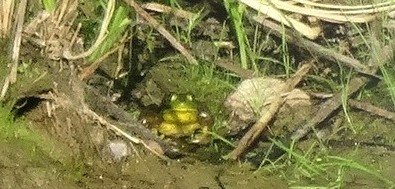7/22/2022
vervain
7/16/2022
turtle chases ducks off favorite rock
7/15/2022
monardas - bee balm - bergamot
7/10/2022
green frog looks like . . .
7/08/2022
7/07/2022
culver's root
7/05/2022
7/04/2022
7/03/2022
mallard families
Female Mallard came out of the grasses with her 3 young ducks (upper right). Then, another Mallard appeared with her 8 younger ducklings. They were all intent on eating duckweed and other aquatic plants growing in the pond.
6/28/2022
On 5/20/2022 we peeked into the nest box, and found several eggs. Not countable, because of the feathers in the box meant to hide the eggs from predators. Since then I have peeked several times more.
6/19/2022
6/17/2022
6/12/2022
smooth penstemon
Foxglove Beardtongue, Penstemon digitalis (also called Smooth Penstemon) has white flowers that bloom for a month or longer.
The tubular flowers attract long-tongued bees such as bumblebees and mason bees, as well as hummingbirds. This is one of the plants we are trying to encourage in the riparian area around the pond.
Good for pollinators!
6/11/2022
iris
6/08/2022
blackbird nest
The Red-winged Blackbird Agelaius phoeniceus gave away the secret location of their nest by screeching at us as we walked around the pond. As I came near the spot, he warned me vocally and hit my hat with his feet as he flew by.
6/06/2022
sora chicks
6/05/2022
6/03/2022
6/01/2022
pussytoes 6-1
5/21/2022
early purple ivy blooms
creeping charlie, gill-over-the-ground, alehoof,
tunhoof, catsfoot, field balm, or run-away-robin.
I admire the shape and texture of the leaves, and
used them in a botanical design project.

































